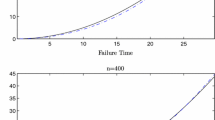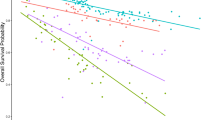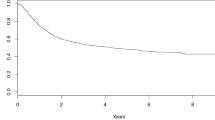Abstract
Current status data arise when the exact timing of an event cannot be observed, and the only available information is whether or not the event has occurred at a random censoring time point. We consider current status data with a cured subgroup, where subjects in this subgroup are not susceptible to the event of interest. We model the cure probability using a generalized linear model with a known link function. For subjects susceptible to the event, we model their survival hazard using a partly linear additive risk model. We show that the penalized maximum likelihood estimate of the parametric regression coefficient is \({\sqrt{n}}\) consistent, asymptotically normal and efficient. The nonparametric cumulative baseline function and nonparametric covariate effect can be estimated with the n 1/3 convergence rate. We propose inference using the weighted bootstrap. Simulations study is employed to assess finite sample performance of the proposed estimate. We analyze the Calcification study using the proposed approach.
Similar content being viewed by others
References
Banerjee S. and Carlin B.P. (2004). Parametric spatial cure rate models for interval-censored time-to-relapse data. Biometrics 60: 268–275
Bellamy S.L., Li Y., Ryan L.M., Lipsitz S., Canner M.J. and Wright R. (2004). Analysis of clustered and interval censored data from a community-based study in asthma. Statistics in Medicine 23: 3607–3621
Chen M., Ibrahim J.G. and Sinha D. (2004). A new joint model for longitudinal and survival data with a cure fraction. Journal of Multivariate Analysis 91: 18–34
Diamond, I. D., McDonald, J. W. (1991). Analysis of current status data. In Demographic applications of event history analysis (pp. 231–252). NY, USA: Oxford University Press.
Farewell V.T. (1986). Mixture models in survival analysis: Are they worth the risk?. Canadian Journal of Statistics 14: 257–262
Gart, J. J., Krewski, D., Lee, P. N., Tarone, R. E., Wahrendorf, J. (1986). Statistical methods in cancer research: Vol. III. The design and analysis of longterm animal experiments. IARC Scientific Publications No. 79. Lyon: International Agency for Research on Cancer.
Groeneboom P. and Wellner J.A. (1992). Information bounds and nonparametric maximum likelihood estimation. Birkhauser, Basel
Huang J. (1996). Efficient estimation for the proportional hazard model with interval censoring. The Annals of Statistics 24: 540–568
Huang J. (1999). Efficient estimation of the partly linear additive Cox model. Annals of Statistics 27: 1536–1563
Lam K.F. and Xue H. (2005). A semiparametric regression cure model with current status data. Biometrika 92: 573–586
Li C.S., Taylor J.M.G. and Sy J.P. (2001). Identifiability of cure models. Statistics and Probability Letters 54: 389–395
Lin D.Y., Oakes D. and Ying Z. (1998). Additive hazards regression with current status data. Biometrika 85: 289–298
Lu W. and Ying Z.L. (2004). On semiparametric transformation cure model. Biometrika 91: 331–343
Ma, S. (2007). Cure model with current status data. Statistica Sinica (in press).
Ma S. and Kosorok M.R. (2005a). Penalized log-likelihood estimation for partly linear transformation models with current status data. Annals of Statistics 33: 2256–2290
Ma S. and Kosorok M.R. (2005b). Robust semiparametric M-estimation and the weighted bootstrap. Journal of Multivariate Analysis 96: 190–217
Martinussen T. and Scheike T.H. (2002). Efficient estimation in additive hazards regression with current status data. Biometrika 89: 649–658
Peng Y. and Dear K.B.G. (2000). A nonparametric mixture model for cure rate estimation. Biometrics 56: 237–243
Sasieni P. (1992). Non-orthogonal projections and their application to calculating the information in a partly linear Cox model. Scandinavian Journal of Statistics 19: 215–233
Shiboski S.C. and Jewell N.P. (1992). Statistical analysis of the time dependence of HIV infectivity based on partner study data. Journal of the American Statistical Association 87: 360–372
Thompson, L. A., Chhikara, R. S. (2003). A Bayesian cure rate model for repeated measurements and interval censoring. In Proceedings of the joint statistical meeting 2003.
van de Geer, S. (2000). Empirical processes in M-Estimation. Cambridge Series in Statistical and Probabilistic Mathematics.
van der Vaart A.W. (1998). Asymptotic statistics. Cambridge University Press, Cambridge
Wahba, G. (1990). Spline models for observational data. SIAM. CBMS-NSF Regional Conference Series in Applied Mathematics.
Xiang, D., Wahba, G. (1997). Approximate smoothing spline methods for large data set in the binary case. In Proceedings of the joint statistical meetings. Biometrics Section, pp. 94–98.
Xue H., Lam K.F. and Li G. (2004). Sieve maximum likelihood estimator for semiparametric regression models with current status data. Journal of the American Statistical Association 99: 346–356
Yu A.K.F., Kwan K.Y.W., Chan D.H.Y. and Fong D.Y.T. (2001). Clinical features of 46 eyes with calcified hydrogel intraocular lenses. Journal of Cataract and Refractive Surgery 27: 1596–1606
Author information
Authors and Affiliations
Corresponding author
About this article
Cite this article
Ma, S. Additive risk model for current status data with a cured subgroup. Ann Inst Stat Math 63, 117–134 (2011). https://doi.org/10.1007/s10463-008-0212-2
Received:
Revised:
Published:
Issue Date:
DOI: https://doi.org/10.1007/s10463-008-0212-2




